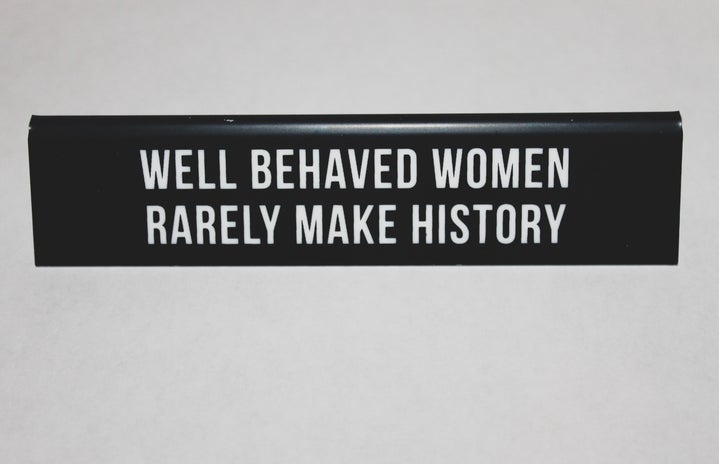Let’s talk about sex. More specifically, let’s talk about the pivotal eighteenth-century change in scientific discourse that redefined what it meant to belong to the female sex and influenced the modern-day disregard for female orgasm (Yes, dirty talk does come naturally to me).
From sixteenth-century transvestite nuns to witchcraft and female sorcery, the content of my Monday morning lectures on Colonial Latin American representations of women, sex and power has been risqué, to say the least. Having studied the wider historical context of Spanish colonialism, what has stood out most for me is how the early-modern debate surrounding sexual anatomy saw the creation of gender identity as we know it today: the Male-Female dichotomy is perhaps one of the most popular ways we use to define someone, even if gender-nonconformity is on the rise in our forward-thinking, post-modern world. And yet, pre-1750, gender was not synonymous with sex: the biological disposition of someone in terms of whether they possessed male or female sexual organs did not determine someone’s gender before the eighteenth century.
Up until the mid-eighteenth century, at the dawn of Modernity and the Age of Enlightenment, it was believed by anatomists that there existed just one sex: that the male was the perfect example of this sex, and the female was an imperfect version of it (not if Beyoncé had been around). All through the Classical, Medieval and Early-Modern periods, difference between men and women was conceptualised as degrees of perfection. While the male sexual organs were exterior to the body, females were considered to possess these same sexual organs as an inversion – the vagina, womb and ovaries were believed to be imperfect, interior versions of the male sex organs.
Scientific theory, until the eighteenth century, was influenced heavily by Hellenistic philosophy and physics, as well as Christian doctrine and theology, which all stated that the human body was made up of humours, which were sort of states of fluid: hot, cold, wet and dry (I promise this isn’t turning into a science lecture). The male was considered hot and dry; the female, wet and cold. Scientists believed that it was a vital heat that gave human beings life and, unsurprisingly, the patriarchal society of the time advocated that females lacked the necessary amount of this vital heat and so were deemed imperfect (they also considered women incapable of rational thought and therefore of inferior mental capacity to men, too).
Medieval anatomy claimed that, since men possessed enough of this vital heat, their genitalia were pushed outside of the body by the heat. They claimed that females did not have sufficient heat, which supposedly explained why their sexual organs remained inside the body as a sort of underdeveloped version of the male’s… This does all sound a bit odd, and it gets weirder: they also believed that too much exercise or physical exertion could produce excessive heat within women, and if this happened, they would develop ‘manly traits’ such as broad shoulders, aggression and facial hair- hence why medieval women were confined to the domestic sphere and widely excluded from other sectors of work and society.
It wasn’t all doom and gloom, however, for the Medieval woman (if you look past not being allowed to own property/having to decide between a life in the convent as a virgin or marriage and children once puberty hit…the list could go on) because another belief of eighteenth-century anatomists was that it was necessary for females to orgasm in order for conception to take place (female orgasm= yay! Women forced to be baby-making machines= not-so-yay).
Indeed, pre-1750, female orgasm was paramount in the bedroom, but only because procreation was the order of the day, every day, by Christian Church and State. Attitudes were soon to change towards women, post-1750, with the development of what Thomas Lacquer coined the ‘two-sex model’.
The pre-1750 model of sex saw sex as a spectrum, in which transgender individuals could occupy a middle ground, due to the belief that all human beings shared in one common sex to various degrees of perfection (Lacquer’s ‘one-sex model’) . A mixture of Enlightenment ideas, imperial expansion, the rise of nationalism and the developing colonial obsession to classify things saw the categorising of human beings as essential in human psychology. Thus, the theory of a sex spectrum was abolished and the idea of two polar sexes developed, which saw the creation and embedding of gender binary in our psychology (think ‘Women are from Venus, Men are from Mars’ motif) as we know it today. Once it was advocated that men and women were of two completely different sexes, and it was discovered that female orgasm was not necessary for conception, the focus on female pleasure during sex greatly diminished and seemingly disappeared (*cries*). Only once the Enlightenment period and the age of conquest and colonialism had brought about the European obsession to classify and assert hierarchy over groups of people (over indigenous people of the ‘New World’ and over women in Christian Europe), did the categorising of men and women as belonging to either Male of Female gender take shape. Categorisation brings about stereotype, and the development of the eighteenth-century brought a regressive attitude towards female sexuality; discovery of the ability to conceive without female orgasm essentially stereotyped the Female as unimportant in the act of sex.
It’s only since the twentieth-century rise in feminism that an increased focus has been given to female sexuality and to the increasing importance placed on female pleasure during sex. Where the pivotal eighteenth-century period saw sex become phallocentric and with total disregard for the importance of female pleasure (I’ll stop with the dirty talk now), the current rise in how much we, women, are talking about sex, listening to our bodies and voicing our desires, is empowering us to challenge and defy the stereotypes and misconceptions about what it means to be Female.

